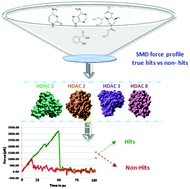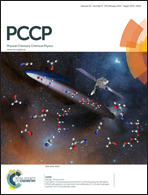A steered molecular dynamics mediated hit discovery for histone deacetylases†
Abstract
The inhibitors of class I histone deacetylases (HDACIs) have gained significant interest in cancer therapeutics. Virtual high throughput screening (vHTS) is one of the popular approaches used in the identification of novel scaffolds of HDACIs. However, an accurate description of ligand–protein flexibilities in the vHTS remains challenging. In this work, we implement an integrated approach, which combines the vHTS with the ‘state-of-the-art’ steered molecular dynamics (SMD). This approach serves as an efficient tool to identify potential hits and characterize their binding potencies against the class I HDACs in a flexible solvent environment. A hybrid pharmacophore-based and structure-based vHTS method identifies the hits with more favourable physico-chemical features against the class I HDACs. Our pharmacophore-based screening enhanced the quality of the vHTS outcomes. Further, the molecular interactions between the hits and the HDACs are investigated using the SMD-driven force profiles, which in turn resulted in filtering the hits with higher binding potencies against the HDACs. Our results, therefore, reveal that vHTS and SMD can be a complementary and effective analytical tool for accelerating the hit identification phase in structure-based drug design.


 Please wait while we load your content...
Please wait while we load your content...